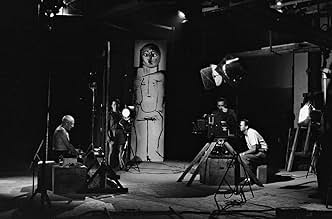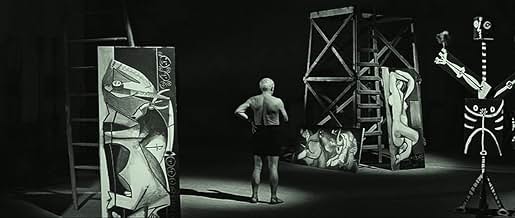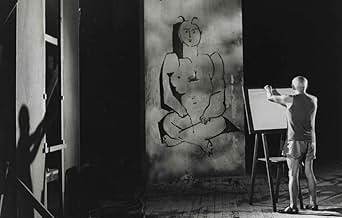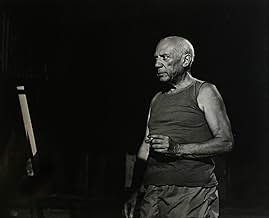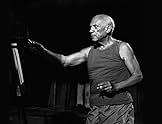Le mystère Picasso
- 1956
- Tous publics
- 1h 18min
NOTE IMDb
7,5/10
2,9 k
MA NOTE
Un film sur Pablo Picasso peignant de nombreuses toiles pour la caméra, nous permettant de voir son procédé créatif à l'oeuvre.Un film sur Pablo Picasso peignant de nombreuses toiles pour la caméra, nous permettant de voir son procédé créatif à l'oeuvre.Un film sur Pablo Picasso peignant de nombreuses toiles pour la caméra, nous permettant de voir son procédé créatif à l'oeuvre.
- Réalisation
- Casting principal
- Récompenses
- 1 victoire et 1 nomination au total
Avis à la une
Henri-Georges Clouzot's The Mystery of Picasso starts by announcing that we will have the pleasure of entering the mind of Pablo Picasso, seeing how he gets his creative inspiration; the film promises us that the only way to do this is to watch Picasso's hand. Picasso paints on paper that the ink bleeds through, putting the camera on the other side of Picasso's canvas and watching the a reversed version painting appear in a seemingly magical way. It becomes clear early on that Clouzot is not wholeheartedly trying to show us how Picasso gets his inspiration; that is a mystery. Clouzot wants to capture the joy of painting. That's what makes this film so entertaining: watching bizarre, beautiful images appear out of nowhere. Sometimes Clouzot uses jump-cuts to show us the different phases of a work in progress at a rapid-fire velocity and then reverses the painting in the same jump-cut technique, deconstructing Picasso's. This is all scored to fiery jazz music. We also see Picasso while painting, as his painting is timed. (Picasso has a great screen presence). Clouzot is equally concerned with deconstructing Picasso's work to understand what makes this fast-working artist tick, showing how impossible that task is, and wowing us all the way through. As far as wowing goes, Clouzot did a pretty good job, with scenes that ranged from unforgettable to pleasantly surprising.
One of the greatest filmmakers of France, Henri-Georges Clouzot, makes a film about his friend Pablo Picasso, perhaps the 20th Century's most renown artist. Clouzot begins with a proposition: if one were present at the conception of a great artistic masterpiece such as Mozart's Jupiter Symphony, and could peek inside the mind of the artist, what would one see? Fortunately, the visual art of painting offers a filmmaker that insight, and so Clouzot begins with Picasso in a dark room with white light directed at an empty canvas. The artist, like a bullfighter, confronts and ultimately displaces the empty space with drama and suspense. Clouzot takes a minimalist approach which chooses to focus on the art rather than the artist, and he achieves this objective by having Picasso sit on one side of a translucent canvas, and the camera on the other capturing only the ink or paint that has been administered, without the distraction or impediment of the artist - pure creation. A window into the mind of the artist! Twenty artworks are created in this manner, each being overlayed with the often suspenseful sounds of Georges Auric's excellent score. With THE MYSTERY OF PICASSO, art becomes exhilarating as one attempts to anticipate what Picasso will do next. "How will he resolve this problem?" Clouzot has created a priceless document for anyone seriously interested in art.
If there was one word to describe this film for me, it would be "inspirational". And I think anyone who practices art or appreciates the process of art, can find this film enjoyable to watch. The film's title speaks for itself. We are engaged in an experimental documentary watching a prodigy at work and trying to unravel the magic of how it all happens. In the beginning there is a voice-over narrated introduction to the film, "Nobody knew what Rimbaud thought of when he wrote the poem "the drunk boat"." And then we realize that we are in for a real treat. Who would ever guess that the master of cubism would allow us to see his creative ideas at work? Most artists are very stubborn about this sort of thing, but then again most famous artists are also pretty ego-centric. The film places the camera behind a canvas that leaves the image transparent so that we can see the painting process without looking over the shoulder. There is a beautiful classical score along with this film and as the drawings progress, Picasso then takes on bigger challenges with paintings. The pacing is just right where the drawing process starts slow and then the strokes become faster with time-lapse photography. There is an amazing moment where the cameraman warns Picasso that he is about to run out of film. Picasso asks how many feet is left and calculates the timing of his painting and just at the last second, Picasso transforms the entire piece into something unexpected and radically different. We can see the spontaneity and playfulness in his work. The end is a mural shaped painting that evolves through many stages until Picasso says something like "its ruined. I have ruined the painting and yet at the same time, its improving." This is an indication of Picasso's fearless drive. When he paints, he is on fire. He works diligently for hours. Its fascinating to see little figures that he will paint over and over with more detail or more color. He wants to emphasize details that seem so ambiguous and its as if he's saying to the audience "look at this" "keep looking at this" "this is important." I first saw this film in the theater when I was about ten or twelve years old. I'm glad my family friends took me to see this. It has inspired me throughout the years. I saw the film again when I was twenty-four and it was just as I remembered it. After it was over, I did the same thing I did when I first saw the film; I pulled out a sketchbook and started drawing. This film is a real treat.
I've always known that Pablo Picasso was one of the most prolific characters of the 20th century. I've also heard about how this film was made many times before, that is with the translucent screen between the camera and Picasso. At the beginning I thought that it was a bit slow and I remember wondering if I was in the midst of 2 hours of Picasso drawing picture after picture. And indeed it was, with a few breaks where we actually see and hear Picasso interact with the camera men. But, amazingly, once you get into watching the short drawing exercises, it becomes very captivating. You aren't sure what he's drawing, and then a line and a squiggle later it is a bull or a woman or whatever. The most mesmerizing part though, as another writer said, was when he was painting the beach scene and he kept painting over his work over and over again. What he was painting over was amazing and it made you wonder why he felt like it just didn't work.
This film reminds us that film is visual - very few words are spoken in Le Mystère Picasso. Instead, the camera just trains in canvas and white paper and watches Picasso create. It could have been boring, but instead it's hypnotic. One learns about the creative process without lecture!
Le saviez-vous
- AnecdotesPablo Picasso is shown creating 20 drawings and paintings from start to finish. He allegedly destroyed these artworks afterwards so they would exist only in the film.
- Citations
Pablo Picasso: I do not look for, I find!
- ConnexionsFeatured in Picasso (1985)
Meilleurs choix
Connectez-vous pour évaluer et suivre la liste de favoris afin de recevoir des recommandations personnalisées
- How long is The Mystery of Picasso?Alimenté par Alexa
Détails
- Date de sortie
- Pays d’origine
- Langue
- Aussi connu sous le nom de
- The Mystery of Picasso
- Société de production
- Voir plus de crédits d'entreprise sur IMDbPro
Box-office
- Montant brut aux États-Unis et au Canada
- 267 836 $US
- Week-end de sortie aux États-Unis et au Canada
- 19 143 $US
- 23 févr. 1986
- Durée
- 1h 18min(78 min)
- Couleur
Contribuer à cette page
Suggérer une modification ou ajouter du contenu manquant


